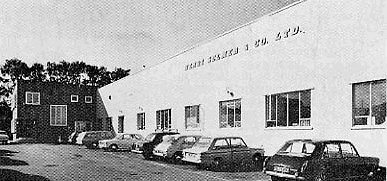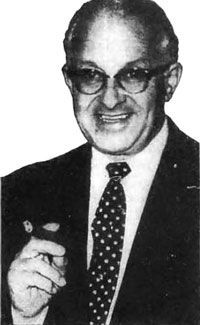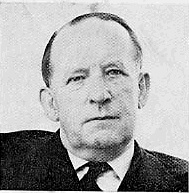
Henri Selmer's Offices, Factory, and Warehouse at Braintree, Essex.
The Home of Selmer Amp Production from 1969 onwards.

Henri Selmer's Offices, Factory, and Warehouse at Braintree, Essex.
The Home of Selmer Amp Production from 1969 onwards.
Would you believe that it all started in France before the Franco-Prussian
War when, in 1858, Henri Selmer was born. He grew up to become a musician,
playing the clarinet in the French Republican Guard and later with the Opera
Comique and Lamoureux Orchestras. By 1885, Henri had started a small
business manufacturing reeds and mouthpieces for clarinets, and by the turn of
the century, this had developed into the production of clarinets themselves. In
1904, Henri's younger brother, Alexandre, who by that time was himself a
musician playing with the Boston Philharmonic and Cincinnati Symphonic
Orchestras, introduced Henri's new instruments to America, where they were a major
success. In order to meet the growing demand, Henri first expanded his first
workshop in Paris at the Place Dancourt, and then in 1919 opened a new factory at
Mantes, about 30km from Paris.
The story now jumps forward in both time and location...... An Englishman called Ben Davis was de-mobbed from the British Army in 1919, after the First World War, and just when Dixieland and jazz was becoming popular in the UK. Being fascinated by the new sounds, Ben taught himself to play the
saxophone. Over the next few years, he played with most of the big bands in the country, and finally formed his own.
Being a man of considerable drive and ambition, Ben Davis could see further potential in the music business. Following a meeting with Henri Selmer in
Paris during1929, Ben established the Selmer Company in London, on the 1st floor of 106, Charing Cross Road,
London WC2 , selling saxophones . Ben's initiative was a success, and the first
premises were soon outgrown, and so he moved to larger premises in Moor Street,
London W1. With further manufacturers' instruments being constantly added to the
Selmer portfolio during the 1930s, a more prestigious retail outlet was
necessary, and so in 1937, the business was moved back to WC2 at 114-116, Charing Cross Road. The company's greatest period of expansion was from 1934 to the start of World War Two in 1939. By the time of the outbreak of war, Selmer was the biggest company in the UK musical instrument industry.

Ben Davies
After the war, Ben's brother Lew Davis, who was himself a leading trombonist, joined the company, and in 1953 a further move away from the French company occurred when Musical and Plastic Industries was formed as a public company; this being the new holding company for Selmer and an associate company called Selcol which made plastic toys and garden furniture. The gap between the two Selmer companies was widened at the end of 1964, when the Davis brothers sold their majority shareholding to a Midlands company who's core business was the manufacture of umbrellas! This company very quickly got into difficulties, mainly due to the umbrella side of the business, and the bankers took control. They appointed a Mr John Cochrane as Chairman & MD, and it was he who steered the Selmer company very successfully during the next period between 1965 and early 1972. The Davis brothers retired to live in the South of France.

John Cockrane
In 1972, John Cockrane retired, and it would appear that from then on, problems developed with Selmers. Around 1974, the company was purchased by Chicago Musical Instruments (CMI), as a base in the UK for their own operations - in particular Lowrey
Organs. The development of amplification was allowed to dwindle and the
Braintree factory was eventually closed. Selmer amps continued to be made for a
while after in a much smaller unit on an industrial estate in the same area.
Amplifier production finally came to a close in the late 1970s.
The Woolpack Lane factory at Braintree stood derelict until it was finally demolished in the mid 1990's. A private housing development now exists on the old factory site.
The Henri Selmer company in France, continued to specialise in wind instruments, which of course have gained an excellent reputation all over the World. Of more interest to guitar enthusiasts however, was the acoustic guitar designed by Mario Maccaferri, which was manufactured for a short time in the 1930's by the French company. This rare instrument gained fame through its use by Django Reinhart.
There is an official Henri Selmer Websites which,as well as describing the companies present
activities, also provide a much more detailed history of the French Selmer
parent company. Click
HERE
.
That's all the information that we have so far obtained on the business side of the UK Selmer story. If anyone can help with further information, particularly on the demise of the Selmer company, please get in touch! Tim and myself will be very grateful. Now for some details of Selmer UK's manufacturing history:
In the early 30's Selmer were actually the first UK musical company to sell amplification equipment - this being equipment made by the Operadio company, which was imported into England from the United States. However, in 1935 the company commenced producing amplifiers under the Selmer brand name, at Charing Cross Road. This facility was given a boost in December 1947, when Selmer purchased RSA; a company that had been producing a range of PA amplifiers since 1946 under the RSA and Truvoice names. It was therefore easy to expand the RSA production into guitar amplification in the mid 1950's with the introduction of models like the early RSA (non-Selmer) Truvoice Model TV15. The TV15 (Stadium) and TV6 (Popular) and similar model designations on early Selmer Truvoice amps was a throwback from that era. (This numbering system was used on the majority of Selmer amps until the mid-60's.) Selmer/RSA amplifier manufacture was carried out at a factory in Theobalds Road, Holborn, London by that time, releasing the Charing Cross Road building for retail purposes and offices. Warehousing facilities for the vast range of instruments which Selmer were now dealing, was a Clerkenwell.
In parallel with the amplification manufacture, Organ production began in 1951 at the Theobald Road factory. One particularly successful model was the Clavioline, a French designed and licensed multi voice keyboard which was intended as an accessory to a piano. Over 15,000 of these instruments were finally made by Selmer UK.
Restrictions on American imports into the UK were lifted in 1955, and Selmer then obtained the franchise to assemble Lowrey organs at Theobalds Road. Cases for organs and Leslie speakers were made in UK by specialist contractors. The electronics of the organ and all the other parts, including speakers, were imported from the Lowrey company in Chicago.
In addition to their involvement with Lowrey Organs, Selmer of course distributed a comprehensive range of Hofner guitars from between 1952 through to the early 1970's. (Selmer were the exclusive distributers of Hofners in the UK from 1958 through to the late 1960's.) As well as throughout the UK, Selmer supplied Hofners to just about all corners of the old British Empire, including Australia, New Zealand, and Canada. In addition, Selmers were the main agent in the UK for Fender guitars and amplifiers, in between the Fender distributorships of Jennings Musical Instruments (Vox) and Ivor Arbiter during the mid-late 1960s. Many a Fender L-Series Strat was delivered to its lucky first owner in a grey
Selmer crock-skin
hardcase. These cases, which were also supplied with some Hofner guitars, are now becoming collectable in their own right.
Selmer also distributed Gibson guitars in the UK during the 1960's.
During the period November 1968 to February 1969, all manufacturing and distribution was moved to be under one roof at the old Selcol factory at Woolpack Lane, Braintree; i.e. the Sales Office was moved from Charing Cross Road, the Warehousing facilities from Clerkenwell Road, and the production plant from Theobalds Road. From then on, two production lines existed at Braintree; one for Lowrey Organ assembly, and the other for the Selmer amplifier production. Only the retail outlet was left at Charing Cross Road - Selmer Musical Instruments Ltd. In addition a highly effective (by the standards of the day!) Quality Control and Service Division was also set up at Braintree. An article in an Industrial Profile dated May 1970 states that "two men work full time on guitar repairs. All but the cheapest of guitars are given a thorough check before
dispatch to dealer." Glorious days indeed!!
.jpg) June 1930 - 106 Charing Cross Road |
.jpg) November 1936 - Moor Street |
.jpg) October 1938 - 114 Charing Cross Road |